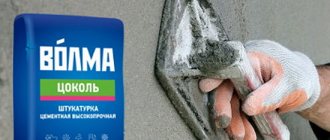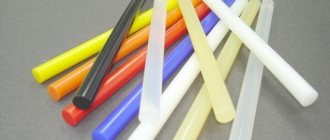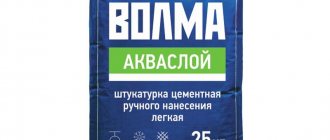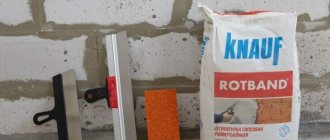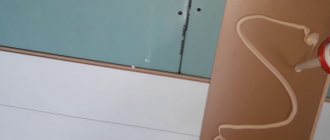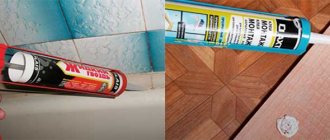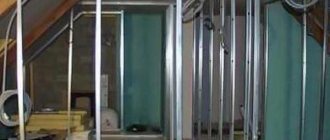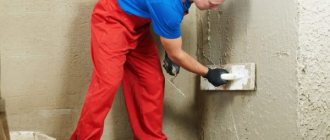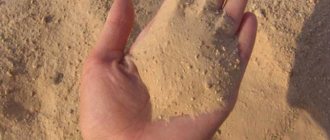Compositions for interior work
Although most mixtures for finishing facades have high performance characteristics and will definitely be able to function in more comfortable conditions in interior spaces, you should not buy them thoughtlessly.
Firstly, some types of plaster have insufficient vapor permeability and can worsen the microclimate. Secondly and most importantly, they cost significantly more. They expect completely different results from interior plaster, so it would be better to choose it according to the following parameters:
1. Light weight.
This requirement is fully met by compositions based on lime or gypsum. Both components are sensitive to moisture, so they can only be used in dry rooms. On the other hand, nothing better can be thought of for wooden bases.
2. Easy to use.
To fulfill this point, the manufacturers themselves tried to create ready-to-apply solutions, usually using polymer binders. The cost of such plaster is quite high, but it performs well as a remixture.
It will hardly be more difficult to work with dry compounds - they need to be mixed with water to obtain a viscous plaster solution. The most popular in this category are gypsum mixtures. In addition, it is a close relative, which means it is an ideal plaster for drywall, which allows you to save a lot on rough leveling of walls.
3. Minimum grain size.
If you do not take into account the decorative finishing, but consider the plaster as a leveling one, then the smallest fractions of the filler can be both an advantage and a disadvantage. It all depends on the condition of the surface
For brick walls, it is better to choose a cement or lime composition with the addition of sand, so that a thick layer of plaster can immediately hide deep seams and large chips.
If you have to process a relatively flat surface, high-quality gypsum plaster such as Rotband or Prospectors will do the job well. If you select such mixtures for finishing, then in most cases you won’t even need putty, and this is a good saving of time and money.
Recommend a quality wall material
Please advise a good quality material for leveling the walls along the beacons and plaster of the walls, also what is the best decorative plaster to decorate the walls in the kitchen and hallway?
Masters online: 482 Orders per week: 1,096 Offers per day: 967
for leveling walls, naturally rotband (no need to invent anything or look for anything, proven material). decorative plaster is purely to your taste; there are a huge number of options from thin-layer paints and Venetian to textured plasters. I would advise: for the corridor (after all, a passage area) something more durable, for example travertine, and for the kitchen something more elegant, definitely washable. You will be advised in more detail at any decor salon. If you're interested, I can tell you the addresses. when choosing a coating, be sure to take into account the presence of small children and pets (thin-layer coatings are easy to damage and very difficult to restore).
Rotband, of course, is better than dark, it is more durable, and choose decorative plaster to match the furniture
depending on the unevenness of the wall, if the minimum is 1-2cm, look at clay-based, only ready-made, if more then gypsum, Volma or anything like that, I like it, and England and Italy are leaders in plasters.
for leveling plaster. You can get a cheaper Rotband... why overpay for a brand.
good evening, dear Galina, depending on how much you need to plaster, if the volume is large and finances do not allow you to “spread up” much, then take VOLMA, it is 50 rubles cheaper than Rotband, and you get a noticeable saving, but there is no difference in quality. I recommend Terraco decorative plaster to my clients. Good luck with your repairs
Hello, Galina. I can recommend using Rotband dry mix for plaster, and Parade products for decorative plaster.
CALL I will suggest a novel
Roma, these are the answers you wrote. the person asking the question is irritated. It’s better not to write anything.
Bases and surfaces on which Volma plaster can be applied
This plaster can be applied to various construction substrates:
- plasterboard and gypsum fiber sheets;
- brick;
- concrete;
- gas and foam concrete;
- gypsum blocks;
- chipboard;
- cement-lime plasters.
Technical specifications
- Drying time for plaster is up to 7 days;
- initial setting period - after 40 minutes;
- the final setting period is no later than 3 hours;
- The recommended layer height is up to 30 mm. Layers applied greater than this parameter are applied in two stages;
- maximum thickness of the plaster layer is 60mm;
- liquid consumption for solution - 0.6 - 0.65 liters of water per 1 kg of mixture;
- plaster "VOLMA" mixture consumption per 1 m2 with a layer thickness of 1 mm - 1 kg;
“VOLMA” plaster, the price per layer of one application, which will be slightly more expensive than other domestic plasters, but this is compensated by the quality of the material, which is not inferior to Rotband, but much cheaper.
Preparing the base for plastering work
Before plastering, the base of the wall or ceiling should be very thoroughly cleaned of various layers, dust, oil stains, dirt and then dried. Detached areas must be strengthened, potholes must be repaired. If there are large irregularities, fungi and white salt deposits, they must be eliminated.
Before applying “VOLMA - Layer” plaster, the base must be coated with a primer that matches the type of base. Based on the rate of moisture absorption, bases are divided into strongly, normally and weakly absorbent. It is recommended to apply VOLMA-Contact primer on weakly absorbent substrates, and VOLMA-Universal or VOLMA-Plast primer on highly absorbent substrates.
A guide corner profile is installed on the protruding outer corners of the wall or ceiling. It is fixed to the base using mounting adhesive or gypsum plaster. In this case, the solution is applied to the inside of the guides and to the surface of the corner of the base. The corner profile should be pressed against the wall first in the center, and then gradually transfer the pressure to the edges.
Technological process of working with Volma - Layer plasters
The required volume of water at room temperature is poured into a clean plastic container at the rate of 1 kg of mixture per 0.6 liters of liquid, and the gypsum mixture is poured. The solution is thoroughly mixed with a construction mixer until smooth and allowed to settle for several minutes.
The process of preparing gypsum plaster using a drill with a special “mixer” attachment.
After 20 minutes, the freshly obtained solution is applied to the prepared surface in a layer of 5-60 mm using a trowel. The applied mixture is leveled using the rule. After the initial coat has completely dried, a second coat can be applied if necessary. After 40-60 minutes after setting and drying, the surface is trimmed using the rule.
Twenty minutes after trimming, the resulting surface is sufficiently moistened with water using a sponge material and smoothed with a wide spatula. The result is a perfectly smooth surface, which is quite suitable for wallpapering. To prepare the surface for touch-up painting, after another 3 hours it is necessary to soak it generously with water and smooth it with a spatula. To decorate a wall with a pattern or texture, various painting and plastering tools are used: rollers, brushes, spatulas, trowels, sponge trowels. With their help, the surface, after leveling, is finished with a decorative pattern.
The drying period on the walls and ceiling is determined by the thickness of the plaster layer, humidity and temperature in the room and is approximately seven days. Supply ventilation will speed up this process.
Finishing with cement base
Cement has always been the most durable material, so it is often used not only in construction, but also in finishing the building. The cement base will provide your home with:
- durability;
- strength;
- crack resistance;
- moisture resistance;
- plastic.
Cement plaster is often used in rooms with high humidity or, conversely, in poorly heated rooms. The cement will provide strength due to its granular base. If you use a mesh when decorating walls, you can lay a thick layer of 5 cm. How many buckets fit in a bag of cement weighing 50 kg. This link will tell you.
Finishing with cement base
Excellent for exterior decoration, due to its resistance to temperature changes and weather changes.
Pros:
- the price is significantly lower than for gypsum;
- a similar mixture can be prepared at home using available materials;
- temperature resistance, as well as to moisture;
- the mixture hardens for a long time, so you can work with it for a long time;
- environmental friendliness.
Flaws:
- does not adhere well to concrete;
- difficult to work with, too heavy material;
- not for use on wood floors.
Cement plaster has been used for many centuries, so many builders trust this finishing material.
Narrow profile compounds
It is customary to consider decorative plaster separately. But here the choice should also be based on the characteristics of the rough surface. Almost any waterproof mixture is suitable for the facade (only acrylic plaster has limitations due to its low vapor permeability). And for interior work, with a well-prepared foundation, you can completely limit yourself to selecting the desired decorative effect.
Sometimes non-standard requirements are imposed on the leveling mixture, dictated by the characteristics of a particular room. To finish such unusual objects, special compositions are produced:
- Warm - with thermal insulating granules of foam glass or expanded polystyrene, expanded volcanic perlite.
- Acoustic - obtained by adding sound absorbers (expanded clay, vermiculite, pumice). To prevent noise insulation properties from being reduced, they are not coated with regular paint.
- Special - X-ray protective (barite mixtures) and acid-resistant silicate compounds.
The best manufacturers
Having decided on the appropriate type of plaster, you can proceed to choosing a brand. On the Russian market, according to consumer reviews, several companies offer mixtures of the highest quality.
1. Knauf.
Gypsum Rotband with excellent properties is produced using German technology in several regions of Russia. This is one of the most expensive brands (from 360 rubles per bag), although it is also the most convenient to use. Knauf Rotband is a very plastic mass that even inexperienced plasterers can safely use.
Unfortunately, Rotband in the Russian version has lost one important quality - stability of characteristics. Each of the four factories operating in the country uses raw materials from its “own” quarry, so dry mixtures differ in shade, viscosity and size class
2. Prospectors.
A fairly large assortment of dry mixtures at an average price of 280 rubles is offered by the domestic brand Starateli. Interior gypsum and cement plaster for the facade of this company has a lower specific gravity due to lighter aggregates. However, this decision by the manufacturers led to the fact that the gypsum finish became somewhat softer than its analogues, although not by much.
Compared to Rotband, the yield of the finished solution after adding water from Starateley is up to 25% higher, which reduces the cost of purchasing material for the same application thickness.
3. Unis.
Like most domestic compounds, it stands out for its quite affordable price. The gypsum Teplon White, which costs about 280 rubles, has earned good reviews from craftsmen due to its economical consumption and elasticity.
At the same time, Teplon allows application in a very thick layer - up to 70 mm, while the rest of the participants in our review are limited to a thickness of 50-60 mm. So for particularly uneven surfaces with large differences in height, this plaster is ideally suited.
4. Volma.
Economy option of good quality from 250 rubles per bag. Despite the predominance of gypsum compositions in the manufacturer’s assortment, Volma focuses on the production of waterproof mixtures. If you need plaster to level walls in damp rooms, then look for it here.
Volma-Sloy is distinguished by its pure white color, minimal shrinkage and very fine grinding, which allows it to be used simultaneously as a finishing coating for painting. Only Chelyabinsk-made products add a fly in the ointment - their quality is slightly lower, and there is a high risk of cracks.
Buying Tips
When purchasing dry plaster mixtures, you need to ensure that the packaging is intact and without signs of wetness. For ready-made solutions not intended for work on facades, storage conditions that do not allow freezing are important. True, it will not be possible to verify this; we can only hope for the integrity of the seller.
Choosing products from famous brands is, in principle, the right decision. But here you should be especially careful, since it is the expensive mixtures that are most often copied in underground workshops
All well-known brands must have distinctive anti-counterfeit signs on their packaging - pay attention to this
Which plaster to choose?
The choice of finishing mixture depends on the scope of work. Which walls will you plaster, internal or external? The quality result always depends on the composition of the mixture. For interior decoration, a gypsum mixture is most often used, but for exterior decoration there is no better solution than cement. Find out the difference between plaster and putty.
Cement plaster
But even among mixtures there are varieties and they differ in additives and fillers, some are needed for better thermal insulation, others are moisture-proof.
Additives are mandatory elements that help improve physical and chemical characteristics.
Operating efficiency is demonstrated by:
- in increasing productivity during finishing work;
- the quality of finishing increases;
- the service life of the structure is also significantly increased;
- repair costs fall;
- moisture resistance increases;
- durability of finishing;
- additives protect against fungal formations;
- increases adhesion to a variety of wall surfaces.
And this is only a small part of the advantages of various solutions that distinguish them from each other. The packaging always lists the properties of all the fillers inside.
So which plaster is better, gypsum or cement? The choice will depend on the type of work carried out during the repair period. Let's look at the properties of each and figure it out.
